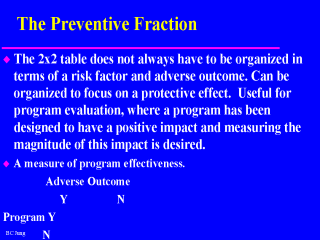| front |1 |2 |3 |4 |5 |6 |7 |8 |9 |10 |11 |12 |13 |14 |15 |16 |17 |18 |19 |20 |21 |22 |23 |24 |25 |26 |27 |28 |29 |30 |review |
 |
Epidemiologic
study designs are being adapted to looking at program effectiveness. A measure of this is
the preventive fraction, which I can only mention here. Similar to other lectures in this series, I can only provide a brief overview of each topic. I am hoping that this lecture will provide a simple foundation for the fascinating area of Research. While Research methodology is supposed to provide structure to how we study the world around us, the structure is somewhat fluid, allowing for different perspectives. These different perspectives allow for more in-depth approaches to learning, but at the same time limits our ability to integrate the findings from these various methods into a cohesive explanation of phenomena in a particular area. Meta-analysis will become more useful in providing an overall structure with which to look at all the contributions made in a particular area so future researchers can build on the work of others, at the same time eliminating duplication of effort. Such dichotomies as basic Vs. applied research, observational Vs. interventional, qualitative Vs. quantitative, will probably continue. However, such differences when viewed as a continuum, as Patton’s typology, are strengths that can help to study any phenomenon that itself follows some continuum of change. |